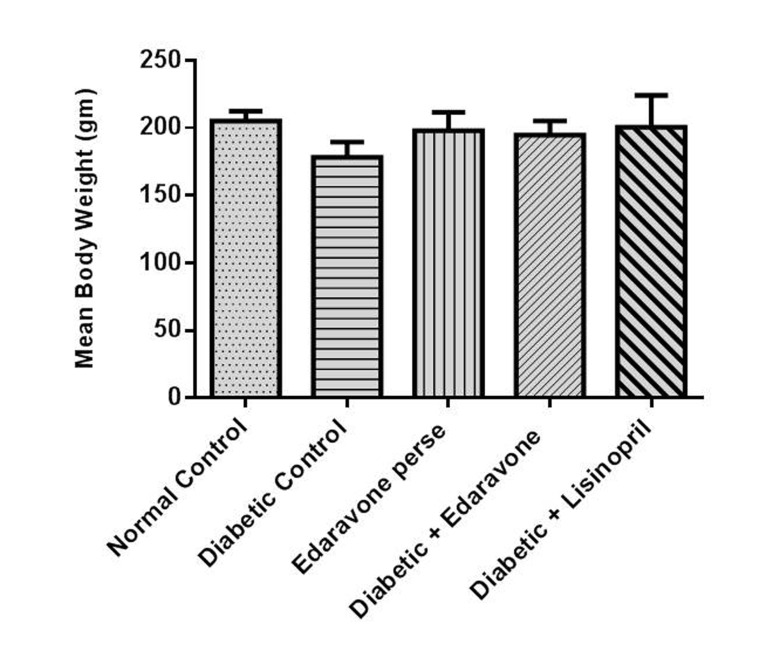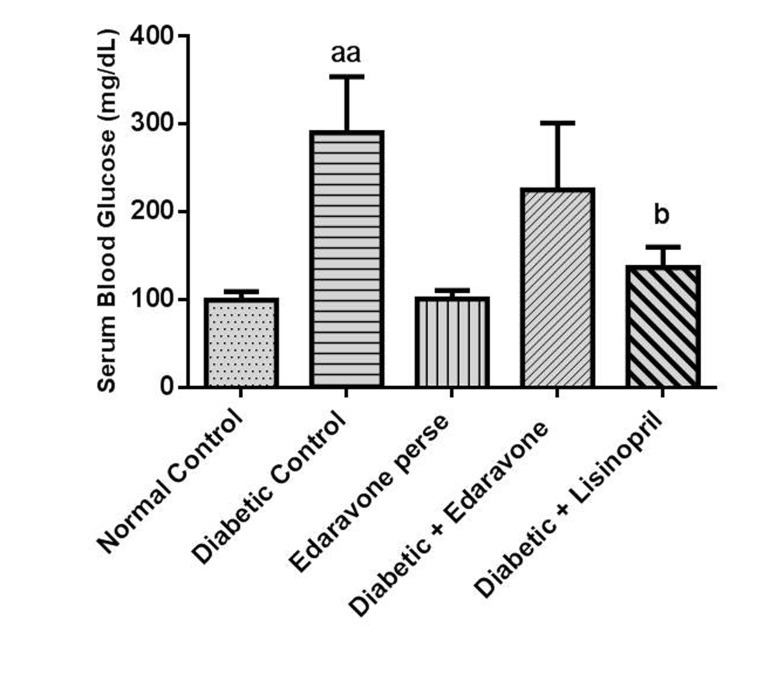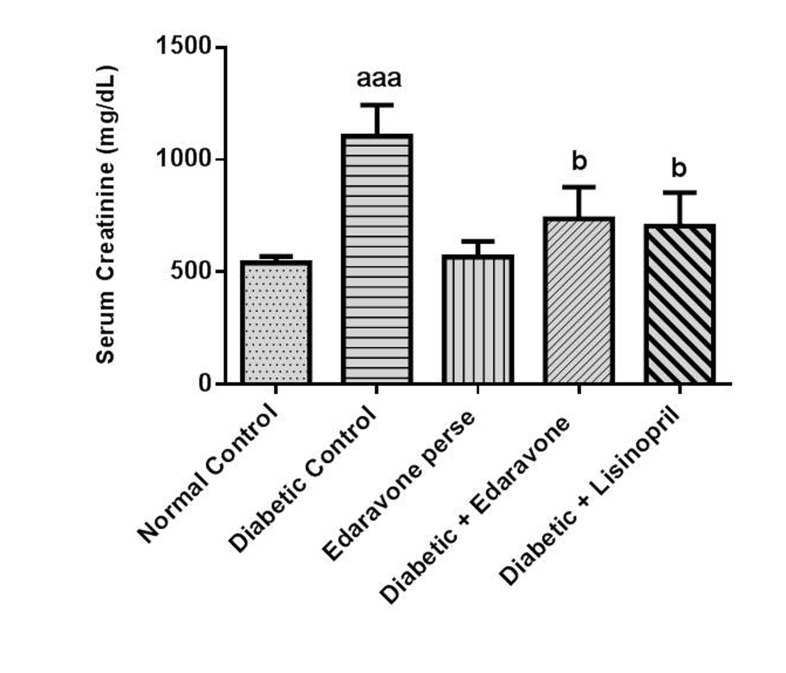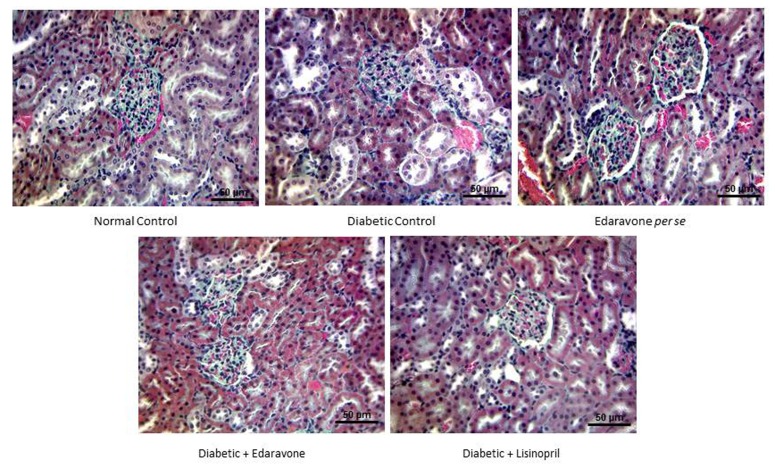Abstract
Edaravone, a synthetic-free radical scavenger, has been reported to reduce ischemia-reperfusion-induced renal injury by improving tubular cell function, and lowering serum creatinine and renal vascular resistance. The present study investigated the effect of edaravone in diabetes mellitus-induced nephropathy in rats. A single administration of streptozotocin (STZ, 55 mg/kg, i.p.) was employed to induce diabetes mellitus in rats. The STZ-administered diabetic rats were allowed for 10 weeks to develop nephropathy. Mean body weight, lipid alteration, renal functional and histopathology were analysed. Diabetic rats developed nephropathy as evidenced by a significant increase in serum creatinine and urea, and marked renal histopathological abnormalities like glomerulosclerosis and tubular cell degeneration. The kidney weight to body weight ratio was increased. Moreover, diabetic rats showed lipid alteration as evidenced by a signifi cant increase in serum triglycerides and decrease in serum high-density lipoproteins. Edaravone (10 mg/kg, i.p., last 4-weeks) treatment markedly prevented the development of nephropathy in diabetic rats by reducing serum creatinine and urea and preventing renal structural abnormalities. In addition, its treatment, without significantly altering the elevated glucose level in diabetic rats, prevented diabetes mellitus-induced lipid alteration by reducing serum triglycerides and increasing serum high-density lipoproteins. Interestingly, the renoprotective effect of edaravone was comparable to that of lisinopril (5 mg/kg, p.o, 4 weeks, standard drug). Edaravone prevented renal structural and functional abnormalities and lipid alteration associated with experimental diabetes mellitus. Edaravone has a potential to prevent nephropathy without showing an anti-diabetic action, implicating its direct renoprotection in diabetic rats.
Go to : 
Chronic diabetes mellitus is one of the leading causes of mortality worldwide [12]. The uncontrolled diabetes mellitus often leads to renal complications. Indeed, nephropathy is a major cause of death among people afflicted with chronic diabetes mellitus [34]. Diabetic nephropathy is associated with an elevation of serum creatinine and urea, which are the index of renal dysfunction [567]. In addition, diabetic nephropathy is structurally associated with glomerulosclerosis and tubular abnormalities [8910]. The progression of nephropathy could be effectively prevented by optimal glycemic control and blood pressure reduction. Recent studies highlight the fact of renal involvement of diabetic dyslipidemia in the development and progression of nephropathy [111213]. Dyslipidemia is a condition that includes hypertriglyceridemia, decreased high-density lipoprotein levels and increased low-density lipoprotein particles. Dyslipidemia is strongly implicated in the occurrence and progression of diabetic nephropathy [1113].
Edaravone, chemically known as 3-methyl-1-phenyl-2-pyrazolin-5-one, is a synthetic-free radical scavenger [14]. It was the first neuroprotective drug to be introduced worldwide, and it has been used in Japan for treating patients with cerebral infarction since a decade [14]. Besides its potent free radical scavenging effects, edaravone possesses anti-apoptotic and anti-necrotic effects in animal models of various diseases [15]. Therefore, it might be necessary to investigate its therapeutic potential in chronic metabolic disorders, which are often associated with oxidative stress and cell death. In fact, numerous studies demonstrated cardiovascular and renal beneficial actions of edaravone. Indeed, edaravone administration just prior to reperfusion has reduced the oxidative stress and improved the long-term clinical outcomes of patients with acute myocardial infarction [16]. Likewise, edaravone pharmacological postconditioning applied before the onset of coronary reperfusion in rats provided a potent myocardial infarct size reduction by decreasing the oxidative stress [17]. Edaravone was also shown to significantly reduce the myocardial infarct size and to improve the cardiac function and left ventricular remodelling by decreasing the cardiac oxidative stress during reperfusion in rabbits [18]. In fact, edaravone was proposed to be a novel option for the treatment of cardiovascular disease [15]. Interestingly, edaravone has been shown to protect canine kidneys from ischemia-reperfusion injury by improving the tubular cell function, and lowering the mean serum creatinine and renal vascular resistance [19]. The present study aimed to investigate the effect of edaravone in diabetes mellitus-induced nephropathy in rats.
Go to : 
This study was carried out for 10 weeks. All the experimental procedures were approved by the AIMST University Human and Animals Ethics Committee (AUHAEC 14/FOP/2013) and complied with the guidelines of the care and use of laboratory animals at the AIMST University, Malaysia. Rats were acclimatised in the AIMST Central Animal House and allowed for access of water and food ad libitum. Rats were exposed to normal day and night cycles.
Streptozotocin (STZ, 55 mg/kg, i.p., once) dissolved in freshly prepared cold 0.1 M citrate buffer was administered to induce diabetes mellitus in rats. Rats with blood glucose level of greater than 180 mg/dL were selected for the study. At the end of the study, the serum glucose level and other biochemical parameters were measured. The kidney was incised for morphological and histopathological studies.
Thirty healthy male Sprague Dawley (SD) rats, weighing between 140~170 g were used in the present study. Five groups were employed in the present study and each group comprised six rats. Lisinopril has been well reported to have renoprotective action in the diabetic condition. Therefore, lisinopril has been employed as a reference compound in the present study.
Group 1 (Normal Control), rats were allowed for free access of water and food, but, no treatment was given. Group 2 (Diabetic Control), rats were administered STZ (55 mg/kg, i.p., once) to induce experimental diabetes mellitus. The STZ-administered diabetic rats were allowed for 10 weeks to develop nephropathy. Group 3 (Edaravone per se), normal rats were administered edaravone (10 mg/kg/day, i.p.) for 4 weeks. Group 4 (Diabetic+Edaravone), the diabetic rats after 6 weeks of STZ administration were treated with edaravone (10 mg/kg/day, i.p.) for the last 4 weeks of 10 weeks experimental protocols. Group 5 (Diabetic+Lisinopril), the diabetic rats after 6 weeks of STZ administration were treated with lisinopril (5 mg/kg/day, p.o.) for the last 4 weeks of 10 weeks experimental protocols.
The development of diabetic nephropathy was assessed in rats by measuring the kidney weight to body weight ratio (KW/BW, g kidney weight/100 g body weight), and measuring serum glucose, serum creatinine and serum urea. In addition, diabetes mellitus-induced lipid alteration was assessed by measuring serum triglycerides and high-density lipoprotein (HDL). All biochemical estimations were done using commercially available Reflotron strips assay kit employing Reflotron Plus Apparatus (Roche Diagnostics, Germany).
At the end of 10 weeks study, the treated and untreated rats were euthanized. Blood sample from each rat was collected in the microcentrifuge tubes, before centrifugation at 9000 rpm for 5 min, to obtain the serum. Using a micropipette, 30 µL of serum was drawn into the pipette (avoiding bubbles) and applied as a drop to the centre of the red application zone on the Reflotron assay strips, without touching the application zone. Before starting the analysis, a calibration for each parameter was done using standard calibration strips. The calibration value was in the range of (631~651), (632~652) and (624~644). The assay strip was placed into the Reflotron apparatus for biochemical analysis. The concentrations of serum glucose, serum creatinine, serum urea, serum triglycerides and serum HDL were expressed in mg/dL.
The isolated kidney was rinsed immediately in saline and kept in 10% buffered formalin. After 10% neutral buffered formalin fixation, the renal tissue was embedded in paraffin. Tissue sections were cut at 4 µm thickness using a microtome, dewaxed, and stained using haematoxylin and eosin (H&E), Periodic acid-Schiff (PAS) and Masson's trichrome. Renal histological changes within the glomeruli, tubules and interstitial areas were assessed using Digital Binocular Microscope at 40X (Model: DN-117M, Brand-Inter Bridge, Quick Lab Sdn. Bhd, Malaysia).
The results were expressed as mean±standard error mean (SEM). Data obtained from various groups were statistically analysed by one way analysis of variance (ANOVA), followed by Tukey's multiple comparison test. The 'p' value of less than 0.05 was considered as statistically significant.
Edaravone and STZ were purchased from Sigma-Aldrich Ltd., St. Louis, MO, USA. Lisinopril dihydrate was procured from AstraZeneca, Malaysia. All other chemicals used in the present study were of analytical grade.
Go to : 
No mortality was observed in the animals within the 10 weeks study. Administration of edaravone (10 mg/kg/day, i.p., 4 weeks) to normal rats did not produce statistically significant per se effects in normal rats. The mean body weight (g) was slightly reduced in diabetic control rats as compared to normal control rats at week 10, but the result was not statistically significant. Likewise, no significant change in body weight at week 10 was observed in diabetic rats with or without edaravone or lisinopril treatments (Fig. 1).
As compared to the normal control group, the diabetic control animals showed a significant increase in the KW/BW (g/100 g BW) (p<0.001). However, diabetic animals treated with either edaravone (p<0.001) or lisinopril (p<0.05) showed significant reductions in the KW/BW as compared to diabetic control group (Fig. 2). Edaravone per se group showed no changes in the KW/BW as compared to the normal control group (Fig. 2).
The blood glucose level in the diabetic control group increased significantly as compared to normal control group at the end of 10 weeks of STZ administration (290.5±25.98 vs 100.1±4.01 mg/dL, p<0.01). The diabetic rats treated with edaravone (10 mg/kg/day, i.p., 4 weeks) showed a reduction in the blood glucose level as compared to diabetic control group, but the result was not statistically significant (Fig. 3). However, diabetic rats treated with lisinopril (5 mg/kg/day, p.o., 4 weeks) showed a significant reduction in the blood glucose level (137.2±9.56, p<0.05) as compared to diabetic control group (Fig. 3).
The serum creatinine level in diabetic control rats increased significantly by 2 fold (p<0.001) as compared to normal control group. However, diabetic rats treated with either edaravone or lisinopril (p<0.05) showed a significant reduction in the serum creatinine level as compared to the diabetic control group (Fig. 4). Edaravone per se group showed no changes in the serum creatinine level as compared to the normal control group (Fig. 4).
The serum urea concentration significantly increased in diabetic control group as compared to normal control group (p<0.001). However, treatment with either edaravone or lisinopril (p<0.01) significantly reduced diabetes mellitus-induced increase in serum urea concentration (Fig. 5). The serum urea concentration in normal rats administered edaravone did not change as compared to the normal control group (Fig. 5).
As compared to the normal control group, there was a significant increase in serum triglyceride level in diabetic control group (p<0.01). Interestingly, edaravone treatment significantly reduced the elevated levels of serum triglycerides in diabetic rats (p<0.05). In addition, lisinopril treated diabetic group also exhibited a significant reduction in serum triglyceride level as compared to diabetic control group (p<0.01) (Fig. 6). There was no significant change in serum triglycerides in between edaravone per se group and normal control group (Fig. 6).
The serum HDL concentration was noted to be significantly reduced in diabetic control rats as compared to normal control rats (p<0.01). However, edaravone treatment significantly elevated the reduced HDL concentration in diabetic rats (p<0.01) (Fig. 7). The Lisinopril-treated diabetic animals also showed a significant elevation of serum HDL concentration as compared to diabetic control group (p<0.05). Edaravone per se group did not show any significant change in the serum HDL level as compared to normal control group (Fig. 7).
Figs. 8, 9, 10 show histological observations of kidney sections stained with H&E, PAS and Masson's trichrome, respectively. Renal tissue sections of control rats showed normal glomeruli and tubules. However, glomerulosclerosis, glomerular hypertrophy, tubular cell degeneration and renal arteriolar hyalinization (thickened wall with narrowed lumen) were noted in the diabetic control group. These histopathological changes have been noted to be markedly reduced by the treatment with either edaravone or lisinopril (Figs. 8, 9, 10).
Go to : 
Diabetes mellitus is a chronic metabolic disorder that is often associated with microvascular complications, including nephropathy, which results in significant morbidity and mortality worldwide [202122]. It is known that chronic hyperglycemia is a key pathologic factor associated with the induction and development of nephropathy during diabetes mellitus. In addition, growing evidence support the fact of significant pathologic involvement of diabetes mellitus-associated dyslipidemia in the development and progression of diabetic nephropathy [7121323]. In the present study, we observed that treatment with edaravone significantly prevented dyslipidemia in diabetic rats and concurrently improved the structure and function of the diabetic kidney, and prevented the development of nephropathy without affecting the elevated glucose concentration. The dose of edaravone (10 mg/kg) employed in the present study has been reported to have renoprotective effect in rats subjected to renal ischemia and reperfusion injury [24]. This was a reason behind the selection of the dose of edaravone in the present study.
STZ induces toxicity to the insulin-producing beta cells of Islets of Langerhans in the pancreas, resulting in type 1 diabetes mellitus. STZ is commonly used to induce diabetes mellitus in rodents [25]. Renal dysfunction can be assessed by measuring serum creatinine and serum urea. Increase in serum creatinine and serum urea is an indication of renal dysfunction [67]. In the present study, STZ-induced diabetic rats exhibited significant elevation of serum creatinine in 10 weeks. Likewise, the serum urea concentration was noted to be significantly elevated in diabetic rats. These results certainly indicate the development of renal dysfunction and nephropathy in STZ-administered diabetic rats in 10 weeks.
Histopathological studies are often used to analyse the renal structural abnormalities. In the present study, histopathological analysis using H&E, PAS and Masson's trichrome staining revealed the occurrence of glomerulosclerosis, mesangial cellularity with extracellular matrix accumulation in the glomerular structure, glomerular hypertrophy, tubular cell degeneration and hyalinization of the vessels in the diabetic kidney. Moreover, the KW/BW was noted to be increased to some extent, but, significantly, in diabetic rats as compared to normal rats. These results confirm the development of renal structural abnormalities and nephropathy in diabetic rats after 10 weeks of STZ administration. Interestingly, the aforementioned structural and functional abnormalities were markedly prevented by treatment with edaravone in diabetic rats, indicating the therapeutic potential of edaravone in preventing the development of nephropathy in diabetic rats. It is worth mentioning that the renoprotective action of edaravone was noted to be similar to that of lisinopril, an angiotensin-converting enzyme inhibitor. Notably, edaravone, without affecting the elevated glucose level, prevented the development of nephropathy in diabetic rats. However, lisinopril was noted to reduce the elevated glucose concentration in diabetic rats.
Diabetic dyslipidemia and lipid elevation could play a key pathologic role in the development and progression of nephropathy [7111213232627]. In the present study, we analyzed the direct relationship between diabetic nephropathy and diabetic dyslipidemia. The serum triglycerides concentration was significantly increased while the serum HDL concentration was significantly decreased in diabetic rats as compared to normal rats in the present study, indicating the development of dyslipidemia in diabetic rats. However, edaravone treatment significantly prevented dyslipidemia in diabetic rats. The diabetic rats treated with lisinopril also showed a significant reduction in diabetic dyslipidemia. These results strongly suggest that dyslipidemia could play a key role in the development of nephropathy in the diabetic condition. The renoprotective effect of edaravone might possibly be associated with its significant potential in preventing the development of dyslipidemia in diabetic rats.
In conclusion, a marked induction of dyslipidemia could play a key pathologic role in the development of nephropathy in diabetic rats. Our study has demonstrated for the first time that edaravone has a potential to prevent diabetes mellitus-associated lipid alteration, which might subsequently have played a key role in preventing the development of nephropathy in diabetic rats. Renal dysfunction is associated with the renal morphological alterations while edaravone treatment could reduce the risk of renal dysfunction by preventing injuries to the renal structure.
Go to : 
ACKNOWLEDGEMENTS
This study was supported by the AIMST Research Grant (AURGC/19/FOP/2013). We thank Ms. M. Mangalarani, Ms. Noor Amalina and Ms. Ooi Bee Eng (AIMST Scientific Officers) for their timely help.
Go to : 
Notes
Author contributions: L.X.L., K.T., C.S.T. and Y.L.T. performed the biochemical and morphological assessments. S.A.S. and M.R. performed sacrifi cing and handling of animals. U.B. interpreted all the histological sections of the kidney. I.C., N.A.A. and S.A.D. supervised and coordinated the study. R.V. conducted all the studies, drafted the manuscript and design of the study. P.B. revised the manuscript critically for the important intellectual content.
Go to : 
References
1. Jahansouz C, Kumer SC, Ellenbogen M, Brayman KL. Evolution of β-cell replacement therapy in diabetes mellitus: pancreas transplantation. Diabetes Technol Ther. 2011; 13:395–418. PMID: 21299398.
2. Roshan B, Stanton RC. A story of microalbuminuria and diabetic nephropathy. J Nephropathol. 2013; 2:234–240. PMID: 24475455.
3. Tsutsui H, Ojima T, Ozaki N, Kusunoki M, Ishiguro T, Oshida Y. Validation of the comprehensive international classification of functioning, disability and health (ICF) core set for diabetes mellitus in patients with diabetic nephropathy. Clin Exp Nephrol. 2015; 19:254–263. PMID: 24840398.

4. Duran-Salgado MB, Rubio-Guerra AF. Diabetic nephropathy and inflammation. World J Diabetes. 2014; 5:393–398. PMID: 24936261.

5. Gitter J, Langefeld CD, Rich SS, Pedley CF, Bowden DW, Freedman BI. Prevalence of nephropathy in black patients with type 2 diabetes mellitus. Am J Nephrol. 2002; 22:35–41. PMID: 11919401.

6. Singh J, Budhiraja S, Lal H, Arora BR. Renoprotection by telmisartan versus benazepril in streptozotocin induced diabetic nephropathy. Iranian J Pharmacol Ther. 2006; 5:135–139.
7. Kadian S, Mahadevan N, Balakumar P. Differential effects of low-dose fenofibrate treatment in diabetic rats with early onset nephropathy and established nephropathy. Eur J Pharmacol. 2013; 698:388–396. PMID: 23085026.

8. Rajavel V, Abdul Sattar MZ, Abdulla MA, Kassim NM, Abdullah NA. Chronic administration of oil palm (Elaeis guineensis) leaves extract attenuates hyperglycaemic-induced oxidative stress and improves renal histopathology and function in experimental diabetes. Evid Based Complement Alternat Med. 2012; 2012:195367. PMID: 23243433.

9. Varatharajan R, Sattar MZ, Chung I, Abdulla MA, Kassim NM, Abdullah NA. Antioxidant and pro-oxidant effects of oil palm (Elaeis guineensis) leaves extract in experimental diabetic nephropathy: a duration-dependent outcome. BMC Complement Altern Med. 2013; 13:242. PMID: 24074026.

10. Singh VP, Bali A, Singh N, Jaggi AS. Advanced glycation end products and diabetic complications. Korean J Physiol Pharmacol. 2014; 18:1–14. PMID: 24634591.

11. Kuwabara T, Mori K, Mukoyama M, Kasahara M, Yokoi H, Saito Y, Ogawa Y, Imamaki H, Kawanishi T, Ishii A, Koga K, Mori KP, Kato Y, Sugawara A, Nakao K. Exacerbation of diabetic nephropathy by hyperlipidaemia is mediated by Toll-like receptor 4 in mice. Diabetologia. 2012; 55:2256–2266. PMID: 22610400.

12. McKay GJ, Savage DA, Patterson CC, Lewis G, McKnight AJ, Maxwell AP. Warren 3/UK GoKinD Study Group. Association analysis of dyslipidemia-related genes in diabetic nephropathy. PLoS One. 2013; 8:e58472. PMID: 23555584.

13. Chen SC, Tseng CH. Dyslipidemia, kidney disease, and cardiovascular disease in diabetic patients. Rev Diabet Stud. 2013; 10:88–100. PMID: 24380085.

14. Kikuchi K, Takeshige N, Miura N, Morimoto Y, Ito T, Tancharoen S, Miyata K, Kikuchi C, Iida N, Uchikado H, Miyagi N, Shiomi N, Kuramoto T, Maruyama I, Morioka M, Kawahara KI. Beyond free radical scavenging: Beneficial effects of edaravone (Radicut) in various diseases (Review). Exp Ther Med. 2012; 3:3–8. PMID: 22969835.

15. Kikuchi K, Tancharoen S, Takeshige N, Yoshitomi M, Morioka M, Murai Y, Tanaka E. The efficacy of edaravone (radicut), a free radical scavenger, for cardiovascular disease. Int J Mol Sci. 2013; 14:13909–13930. PMID: 23880849.

16. Tsujita K, Shimomura H, Kaikita K, Kawano H, Hokamaki J, Nagayoshi Y, Yamashita T, Fukuda M, Nakamura Y, Sakamoto T, Yoshimura M, Ogawa H. Long-term efficacy of edaravone in patients with acute myocardial infarction. Circ J. 2006; 70:832–837. PMID: 16799234.

17. Zhang YM, Wang Y, Liu XH, Zhang DW. Cardioprotective effect of edaravone pharmacological postconditioning on acute myocardial ischemia/reperfusion injury: experiment with rats. Zhonghua Yi Xue Za Zhi. 2008; 88:2558–2561. PMID: 19080651.
18. Onogi H, Minatoguchi S, Chen XH, Bao N, Kobayashi H, Misao Y, Yasuda S, Yamaki T, Maruyama R, Uno Y, Arai M, Takemura G, Fujiwara H. Edaravone reduces myocardial infarct size and improves cardiac function and remodelling in rabbits. Clin Exp Pharmacol Physiol. 2006; 33:1035–1041. PMID: 17042911.

19. Tahara M, Nakayama M, Jin MB, Fujita M, Suzuki T, Taniguchi M, Shimamura T, Furukawa H, Todo S. A radical scavenger, edaravone, protects canine kidneys from ischemia- reperfusion injury after 72 hours of cold preservation and autotransplantation. Transplantation. 2005; 80:213–221. PMID: 16041266.
20. Chan JL, Abrahamson MJ. Pharmacological management of type 2 diabetes mellitus: rationale for rational use of insulin. Mayo Clin Proc. 2003; 78:459–467. PMID: 12683698.

21. Balakumar P, Arora MK, Ganti SS, Reddy J, Singh M. Recent advances in pharmacotherapy for diabetic nephropathy: current perspectives and future directions. Pharmacol Res. 2009; 60:24–32. PMID: 19427582.

22. Rutledge JC, Ng KF, Aung HH, Wilson DW. Role of triglyceride-rich lipoproteins in diabetic nephropathy. Nat Rev Nephrol. 2010; 6:361–370. PMID: 20440276.

23. Balakumar P, Kadian S, Mahadevan N. Are PPAR alpha agonists a rational therapeutic strategy for preventing abnormalities of the diabetic kidney? Pharmacol Res. 2012; 65:430–436. PMID: 22285932.

24. Doi K, Suzuki Y, Nakao A, Fujita T, Noiri E. Radical scavenger edaravone developed for clinical use ameliorates ischemia/reperfusion injury in rat kidney. Kidney Int. 2004; 65:1714–1723. PMID: 15086910.

25. Szkudelski T. The mechanism of alloxan and streptozotocin action in B cells of the rat pancreas. Physiol Res. 2001; 50:537–546. PMID: 11829314.
26. Toyama T, Shimizu M, Furuichi K, Kaneko S, Wada T. Treatment and impact of dyslipidemia in diabetic nephropathy. Clin Exp Nephrol. 2014; 18:201–205. PMID: 24198049.

27. Balakumar P, Varatharajan R, Nyo YH, Renushia R, Raaginey D, Oh AN, Akhtar SS, Rupeshkumar M, Sundram K, Dhanaraj SA. Fenofibrate and dipyridamole treatments in low-doses either alone or in combination blunted the development of nephropathy in diabetic rats. Pharmacol Res. 2014; 90:36–47. PMID: 25263930.

Go to : 




 PDF
PDF ePub
ePub Citation
Citation Print
Print












 XML Download
XML Download